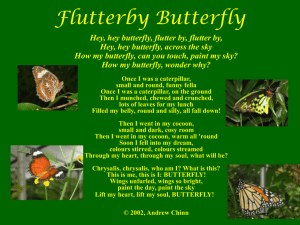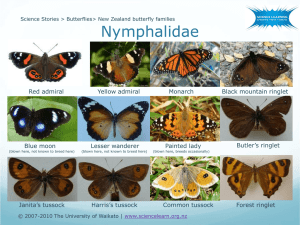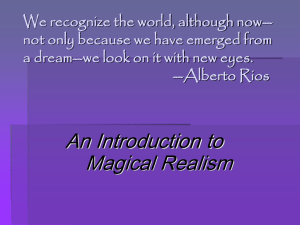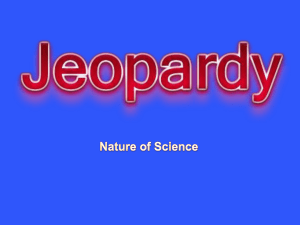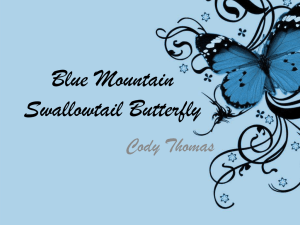Butterflies
advertisement
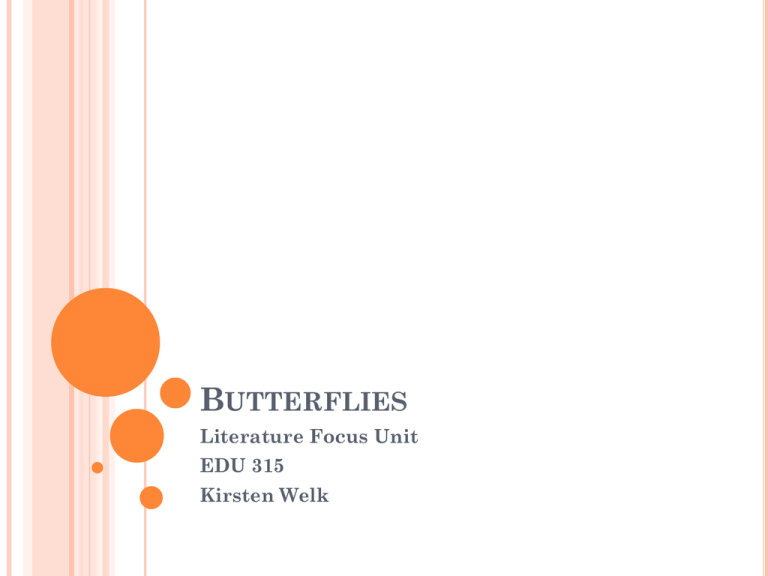
BUTTERFLIES Literature Focus Unit EDU 315 Kirsten Welk LITERATURE SELECTION • • • • • • • • • • • • • • • The Big Butterfly Book by Susanne Santoro Whayne Becoming Butterflies by Anne Rockwell Butterfly Count by Sneed B. Collard III Butterflies (Animal World) by Donna Bailey Butterflies (First Discovery Book) by Gallimard Jeunesse Butterflies: Monarchs, Moths, &More – Up Close and Unexpected by Joni Phelps Hunt Butterflies for Kids (Wildlife for Kids Series) by E. Jaediker Norsgaard Butterfly House by Eve Bunting Butterfly Hunt by Yoshi Caterpillar Caterpillar by Vivian French Charlie the Caterpillar by Dom Deluise Caterpillar to Butterfly by Oliver Owen The Magic School Bus: Butterfly and Dog Beast: A Book About Butterfly Camouflage by Nancy E. Krulik Monarch Butterflies: Mysterious Travelers by Bianca Lavies The Butterfly: A Circular Pop-Up Book by David Hawcook • The Little Butterfly by Sherry Shanan The Swallowtail Butterfly by Hidekazu Kubu The Very Hungry Caterpillar by Eric Carle • Flutterfly Butterflies by Sonja Lamut • • THEME STUDY • • Students will take part in a thematic unit on butterflies. This unit will integrate reading and writing with social studies, science, mathematics, art, music, and physical education. Students will develop a better understanding about different types of butterflies, their life cycle, their environment and also terms that go along with butterflies. LANGUAGE ARTS: READING ACTIVITIES • • • • • • • • Students will read various fiction and non-fiction books about butterflies using a variety of reading styles. Students will read instructions on how to properly care for their caterpillars/butterflies. Students will read butterfly poetry. Students will share their descriptions of butterflies. Students will share their butterfly stories. Teacher reads aloud the book The Very Hungry Caterpillar by Eric Carle. Teacher reads aloud the book Butterfly House by Eve Bunting. Students will read the butterfly terms from the word wall. LANGUAGE ARTS: WRITING ACTIVITIES • • • • • Students will write a short story about a butterfly. Students will write about how a caterpillar becomes a butterfly. Students will add butterfly terms to the word wall. Students will describe many different butterflies and choose their favorite. Students will journal daily about the caterpillar/butterfly in the classroom. LANGUAGE ARTS: SPEAKING ACTIVITIES Students will participate in a game of “I Spy” using the butterfly terms on the word wall. Students will participate in small group discussions about their favorite type of butterfly. Students will use the author chair to read their butterfly story aloud. Students will participate in a class discussion on the book The Very Hungry Caterpillar by Eric Carle. Students will talk about the life stages of a butterfly. Students will act out the story The Very Hungry Caterpillar by Eric Carle. LANGUAGE ARTS: LISTENING ACTIVITIES • • • • Students will listen respectfully as classmates share their butterfly descriptions and stories. Students will listen as the teacher reads the books aloud. Students will listen as the teacher discusses the different types of butterflies and the life cycles of butterflies. Students will listen to their peers opinions and ideas during class discussions. LANGUAGE ARTS: VIEWING ACTIVITIES • • • • • • • • Students will view different types of butterflies. Students will view the life cycle process of a butterfly. Students will view photographs of butterflies. Students will view the butterfly art. Students will view the butterfly word wall. Students will view pictures of the different life cycle stages of a butterfly. Students will watch a National Geographic Video on Monarch Butterflies. Students will view the following websites: www.kidsbutterfly.org and www.thebutterflysite.com LANGUAGE ARTS: VISUALLY REPRESENTING ACTIVITIES Students will draw pictures of butterflies. Students will take pictures of the classroom caterpillar and butterfly to show the changes. Students will create a butterfly word wall. Students will divide the paper into four different sections and use pasta to show the life cycle of a butterfly. (Rice=eggs, Bite-size lasagna=Caterpillar, shells=chrysalis, bow-tie= butterfly) Students will draw pictures of a caterpillar’s life cycle from beginning to end. SCIENCE ACTIVITIES Students will investigate the different parts of a butterfly. Students will observe a butterflies life cycle in class with the class caterpillar. Students will learn about the environment and eating pattern of a butterfly as they care for the one in the classroom. Students will investigate why butterflies are important to the environment. MATHEMATICS ACTIVITIES Students will measure the length of caterpillars and compare sizes. Students will sort fake butterflies by size and color. Students will measure the temperature of the environment that the caterpillars are living in. Students will chart the growth of the caterpillar each day and figure out how much the caterpillar grew each day. Students will take a survey on favorite butterflies and will graph the results. Students will find the line of symmetry on butterflies. SOCIAL STUDIES ACTIVITIES Students will map out where different types of butterflies live on a map. They will identify where most of the butterflies live. Students will learn about the migration of the Monarch Butterfly. A worker from the zoo will come in to talk about butterflies. Fieldtrip to the zoo. MUSIC AND ART ACTIVITIES Students will create a coffee filter butterfly. Students will create butterfly wings. Students will listen to butterfly songs. Students will create a butterfly using their feet. Students will decorate the lifecycle project they created. Students will make flying butterflies. Students will make edible caterpillars. PHYSICAL EDUCATION ACTIVITIES Students participate in a scavenger hunt looking for different items that pertain to butterflies. Students act as caterpillars, wrap them with toilet paper (represents chrysalis) then have them spread their wings and “break free”. Students practice different butterfly/caterpillar movements. Students will perform a relay performing certain “butterfly” skills such as moving like a caterpillar or butterfly. Students will go on a nature walk to look for different butterflies or caterpillars. TECHNOLOGY www.kidsbutterfly.org www.thebutterflysite.com http://teacher.scholastic.com/products/instructor/ monarchs.htm National Geographic Video on Monarch Butterflies Eyewitness Butterfly and Moth Video The Very Hungry Caterpillar Video The Magic School Bus Video Bugs, Bugs, Bugs! Digital Photography LANGUAGE ARTS STRATEGIES Activating Background Knowledge: Students will think about what they already know about butterflies. Brainstorming: Students will think of many ideas related to butterflies through different writing activities. Connecting: Students will connect butterflies to themselves, the world around them, and literature by writing. Monitoring: Students keep track of their understanding or success through many different activities. Predicting: Students anticipate events in stories we read. Questioning: Students ask questions about butterflies to clarify or expand meaning. Summarizing: Students pick out the big ideas about butterflies to remember. LANGUAGE ARTS SKILLS Print: Students will recognize words on the word wall. Comprehension: Students will compare and contrast different butterflies. Language: Students will use proper sentence structure in their writing assignments. Reference: Students will graph data collected on butterflies. Study: Students will follow simple directions pertaining to different projects. GROUPING PATTERNS Large Group: large group conversations, reading books, butterfly games, word wall, class survey, mapping where butterflies live, scavenger hunt, relay race, nature walk Small Group: small group discussions, taking pictures, measuring caterpillars, measuring temperature, caterpillar movement activity, graphing data Individual: reading stories, writing stories and descriptions, journaling, drawing butterflies, creating the life cycle of a butterfly, art projects ASSESSMENTS Portfolio of work: artwork, graphs, science experiments and different writing assignments Participation in group conversations Checklist of the butterfly unit Informal observation of small group discussions Journal Entries and KWL Chart: Rubric Analytic Writing Traits Rubric for stories Checklist for Science Journals
